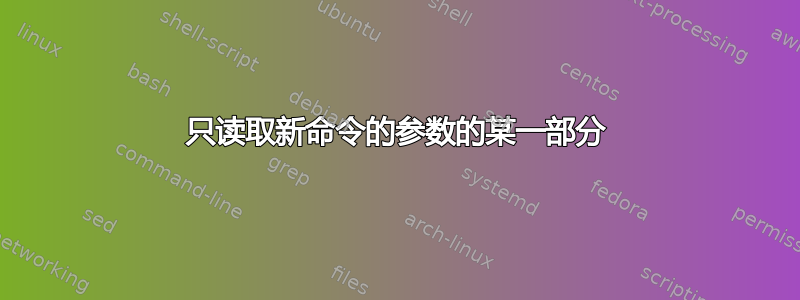
我使用 glossaries-extra 包来获取符号列表。由于某些与此无关的原因,我定义了一个新命令
\newcommand{\symb}[3][]{%
\glsxtrnewsymbol[#1]{#2}{#3}%
}
因此我的词汇表条目的形式为:
\symb[description={Set of Smooth Vector Fields}]{vfs}{\ensuremath{\mathfrak{X}}}
我想将这些“转移”到我大学的论文模板中,他们不使用词汇表包,而是定义一个应输入符号的环境:
\begin{symbols}
\sym{\ensuremath{\mathfrak{X}}}{Set of Smooth Vector Fields}
\end{symbols}
这只是一个制表符环境,它直接打印您在命令 \sym 的参数中写下的任何内容。所以我的计划是定义类似
\renewcommand{\symb}[3][]{%
\glsxtrnewsymbol[#1]{#2}{#3}%
\sym{#3}{\glsdesc{#2}}%
}
这种方法是可行的,但使用词汇表包会以某种方式干扰大学样式文件的另一部分。因此,我想定义
\renewcommand{\symb}[3][]{%
\sym{#3}{#1}%
}
但是我不想在第二个参数中使用“description={Set of Smooth Vector Fields}”,我想要的是“Set of Smooth Vector Fields”。有没有办法从 \symb 的第二个参数中只提取“Set of Smooth Vector Fields”部分?
解决方案:@Schrödinger 猫解决方案的简化版本对我有用:
\newcommand{\symb}[3][]{%
\def\mysplit##1=##2{\sym{#3}{##2}}%
\expandafter\mysplit#1%
}
答案1
使用以下代码,重新定义的例程\symb执行以下操作:
参数被\glsxtrnewsymbol原封不动地传递。
从可选参数\sym中提取描述后,将参数传递给,如下所示:\symb
如果该参数不包含前导短语“description=”,则按原样传递。(整个短语周围的空格标记和/或“description”与“=”之间的空格标记均被考虑在内。)
如果该参数确实包含前导短语“description=”,则该短语会被删除。
- 如果余数仅包含空格标记或什么都没有,则提取结果将为空/根本不包含任何标记。
- 如果余数由单个非分隔参数组成,即单个非括号标记或一组嵌套在括号中的标记,则将删除围绕整个余数的一层括号(如果存在),然后将删除围绕整个余数的空格标记。
- 如果余数由除单个非分隔参数以外的其他内容组成,则不会删除括号,但会删除整个余数周围的空格。
由于和\sym对\glsxtrnewsymbol我来说不可用,我提供了“虚拟定义”,它们什么也不做,只是以去标记化的方式传递它们的参数,嵌套在尖括号中。
我即兴完成了所有这些,因此没有任何保证。;-)
还请注意我关于您的非重新定义的\symb例程以及在花括号中嵌套任意材料{以及}将其传递给另一个宏时形成可选参数的评论。
整个“机制”的实现无需使用任何......\if..因此,该机制不会被包含不匹配或或的宏观参数所混淆。\else\fi\if\else\fi
\documentclass{article}
\makeatletter
%%=============================================================================
%% Check whether argument is empty:
%%=============================================================================
%% \UD@CheckWhetherNull{<Argument which is to be checked>}%
%% {<Tokens to be delivered in case that argument
%% which is to be checked is empty>}%
%% {<Tokens to be delivered in case that argument
%% which is to be checked is not empty>}%
%%
%% Due to \romannumeral0-expansion the result is delivered after two
%% expansion-steps/after two "hits" by \expandafter.
%%
%% The gist of this macro comes from Robert R. Schneck's \ifempty-macro:
%% <https://groups.google.com/forum/#!original/comp.text.tex/kuOEIQIrElc/lUg37FmhA74J>
%%
\newcommand\UD@CheckWhetherNull[1]{%
\romannumeral0\expandafter\@secondoftwo\string{\expandafter
\@secondoftwo\expandafter{\expandafter{\string#1}\expandafter
\@secondoftwo\string}\expandafter\@firstoftwo\expandafter{\expandafter
\@secondoftwo\string}\@firstoftwo\expandafter{} \@secondoftwo}%
{\@firstoftwo\expandafter{} \@firstoftwo}%
}%
%%=============================================================================
%% Check whether argument is blank (empty or only spaces):
%%=============================================================================
%% -- Take advantage of the fact that TeX discards space tokens when
%% "fetching" _un_delimited arguments: --
%% \UD@CheckWhetherBlank{<Argument which is to be checked>}%
%% {<Tokens to be delivered in case that
%% argument which is to be checked is blank>}%
%% {<Tokens to be delivered in case that argument
%% which is to be checked is not blank}%
\newcommand\UD@CheckWhetherBlank[1]{%
\romannumeral\expandafter\expandafter\expandafter\@secondoftwo
\expandafter\UD@CheckWhetherNull\expandafter{\@firstoftwo#1{}.}%
}%
%%=============================================================================
%% Exchange two arguments. (From each argument an outermost level of
%% surrounding braces will be removed if present.)
%%=============================================================================
\newcommand\UD@Exchange[2]{#2#1}%
%%=============================================================================
%% Check whether argument's leading tokens form a specific
%% token-sequence that does not contain explicit character tokens of
%% category code 1 or 2:
%%=============================================================================
%% \UD@CheckWhetherLeadingTokens{<argument which is to be checked>}%
%% {<a <token sequence> without explicit
%% character tokens of category code
%% 1 or 2>}%
%% {a <single non-space token> that does
%% _not_ occur in <token sequence> >}%
%% {<internal token-check-macro>}%
%% {<tokens to be delivered in case
%% <argument which is to be checked> has
%% <token sequence> as leading tokens>}%
%% {<tokens to be delivered in case
%% <argument which is to be checked>
%% does not have <token sequence> as
%% leading tokens>}%
\newcommand\UD@CheckWhetherLeadingTokens[4]{%
\romannumeral0\UD@CheckWhetherNull{#1}%
{\UD@Exchange{ }\expandafter\@secondoftwo}%
{\expandafter\@secondoftwo\string{\expandafter
\UD@@CheckWhetherLeadingTokens#4#3#1#2}{}}%
}%
\newcommand\UD@@CheckWhetherLeadingTokens[1]{%
\expandafter\UD@CheckWhetherNull\expandafter{\@firstoftwo{}#1}%
{\UD@Exchange{\@firstoftwo}}{\UD@Exchange{\@secondoftwo}}%
{\UD@Exchange{ }{\expandafter\expandafter\expandafter\expandafter
\expandafter\expandafter\expandafter}\expandafter\expandafter
\expandafter}\expandafter\@secondoftwo\expandafter{\string}%
}%
%%=============================================================================
%% \UD@internaltokencheckdefiner{<internal token-check-macro>}%
%% {<token sequence>}%
%% Defines <internal token-check-macro> to snap everything
%% until reaching <token sequence>-sequence and spit that out
%% nested in braces.
%%=============================================================================
\newcommand\UD@internaltokencheckdefiner[2]{%
\@ifdefinable#1{\long\def#1##1#2{{##1}}}%
}%
%%=============================================================================
\UD@internaltokencheckdefiner{\UD@ExtractDescriptionEqual}{description=}%
\UD@internaltokencheckdefiner{\UD@ExtractDescriptionSpaceEqual}{description =}%
\UD@internaltokencheckdefiner{\UD@ExtractDescriptionEqualSpace}{description= }%
\UD@internaltokencheckdefiner{\UD@ExtractDescriptionSpaceEqualSpace}{description = }%
\UD@internaltokencheckdefiner{\UD@ExtractSpaceDescriptionEqual}{ description=}%
\UD@internaltokencheckdefiner{\UD@ExtractSpaceDescriptionSpaceEqual}{ description =}%
\UD@internaltokencheckdefiner{\UD@ExtractSpaceDescriptionEqualSpace}{ description= }%
\UD@internaltokencheckdefiner{\UD@ExtractSpaceDescriptionSpaceEqualSpace}{ description = }%
\UD@internaltokencheckdefiner{\UD@ExtractSpace}{ }%
%%=============================================================================
%% Trim all leading and trailing spaces:
%%=============================================================================
\newcommand\UD@RemoveSpaces[1]{%
\romannumeral0\@firstofone{\UD@TrimTrailSpaceLoop{#1}.#1\UD@Bizarre} \UD@Bizarre\relax\UD@Bizarre
}%
\@ifdefinable\UD@TrimTrailSpaceLoop{%
\long\def\UD@TrimTrailSpaceLoop#1#2 \UD@Bizarre#3\relax\UD@Bizarre{%
\UD@CheckWhetherNull{#3}{%
\UD@TrimLeadSpaceLoop{#1}%
}{%
\@firstofone{\expandafter\UD@TrimTrailSpaceLoop\expandafter{\@gobble#2}#2\UD@Bizarre} \UD@Bizarre\relax\UD@Bizarre
}%
}%
}%
\@ifdefinable\UD@gobblespace{%
\@firstofone{\def\UD@gobblespace} {}%
}%
\newcommand\UD@TrimLeadSpaceLoop[1]{%
\UD@CheckWhetherLeadingTokens{#1}{ }{.}{\UD@ExtractSpace}{\expandafter\UD@TrimLeadSpaceLoop\expandafter{\UD@gobblespace#1}}{ #1}%
}%
%%=============================================================================
%% Extract description:
%%=============================================================================
\newcommand\UD@ExtractDescription[1]{%
\romannumeral0%
\UD@CheckWhetherLeadingTokens{#1}{ description = }{.}{\UD@ExtractSpaceDescriptionSpaceEqualSpace}{%
\expandafter\UD@ExtractDescriptionCheckArgAmount\expandafter{\UD@ExtractSpaceDescriptionSpaceEqualSpace#1}%
}{%
\UD@CheckWhetherLeadingTokens{#1}{ description= }{.}{\UD@ExtractSpaceDescriptionEqualSpace}{%
\expandafter\UD@ExtractDescriptionCheckArgAmount\expandafter{\UD@ExtractSpaceDescriptionEqualSpace#1}%
}{%
\UD@CheckWhetherLeadingTokens{#1}{ description =}{.}{\UD@ExtractSpaceDescriptionSpaceEqual}{%
\expandafter\UD@ExtractDescriptionCheckArgAmount\expandafter{\UD@ExtractSpaceDescriptionSpaceEqual#1}%
}{%
\UD@CheckWhetherLeadingTokens{#1}{ description=}{.}{\UD@ExtractSpaceDescriptionEqual}{%
\expandafter\UD@ExtractDescriptionCheckArgAmount\expandafter{\UD@ExtractSpaceDescriptionEqual#1}%
}{%
\UD@CheckWhetherLeadingTokens{#1}{description = }{.}{\UD@ExtractDescriptionSpaceEqualSpace}{%
\expandafter\UD@ExtractDescriptionCheckArgAmount\expandafter{\UD@ExtractDescriptionSpaceEqualSpace#1}%
}{%
\UD@CheckWhetherLeadingTokens{#1}{description= }{.}{\UD@ExtractDescriptionEqualSpace}{%
\expandafter\UD@ExtractDescriptionCheckArgAmount\expandafter{\UD@ExtractDescriptionEqualSpace#1}%
}{%
\UD@CheckWhetherLeadingTokens{#1}{description =}{.}{\UD@ExtractDescriptionSpaceEqual}{%
\expandafter\UD@ExtractDescriptionCheckArgAmount\expandafter{\UD@ExtractDescriptionSpaceEqual#1}%
}{%
\UD@CheckWhetherLeadingTokens{#1}{description=}{.}{\UD@ExtractDescriptionEqual}{%
\expandafter\UD@ExtractDescriptionCheckArgAmount\expandafter{\UD@ExtractDescriptionEqual#1}%
}{ #1}%
}%
}%
}%
}%
}%
}%
}%
}%
\newcommand\UD@ExtractDescriptionCheckArgAmount[1]{%
\expandafter\UD@CheckWhetherBlank\expandafter{\@gobble#1}{ }{%
\expandafter\UD@CheckWhetherBlank\expandafter{\@gobbletwo#1}{%
\UD@Exchange{ }{\expandafter\expandafter\expandafter\expandafter\expandafter\expandafter\expandafter}%
\expandafter\UD@RemoveSpaces\expandafter{\@secondoftwo#1}%
}{%
\UD@Exchange{ }{\expandafter\expandafter\expandafter\expandafter\expandafter\expandafter\expandafter}%
\expandafter\UD@RemoveSpaces\expandafter{\@firstoftwo{}#1}%
}%
}%
}%
%%=============================================================================
%% Your definition of \symb with a modification:
%% When passing arbitrary arguments as optional arguments, I strongly recommend
%% nesting them in braces for ensuring that nesting of square brackets won't
%% lead to problems:
%%=============================================================================
\newcommand{\symb}[3][]{%
\glsxtrnewsymbol[{#1}]{#2}{#3}% <- Here the content of #1 is arbitrary.
}% % Problems due to nested square brackets
% might occur in case #1 contains
% [ or ].
% Some day someone might do something like
% \symb[{description=optional\macro[macro's optional]}]{...}{...}.
% Therefore nest #1 in braces.
% These braces will be removed by LaTeX
% when processing \glsxtrnewsymbol's
% optional argument.
% They prevent confusion when it comes
% to nesting optional arguments within
% optional arguments.
%%=============================================================================
%% Redefinition of \symb:
%%=============================================================================
\renewcommand{\symb}[3][]{%
\romannumeral0%
\expandafter\expandafter\expandafter\UD@Exchange
\expandafter\expandafter\expandafter{%
\expandafter\expandafter\expandafter{\UD@ExtractDescription{#1}}}{ \sym{#3}}%
\glsxtrnewsymbol[{#1}]{#2}{#3}%
}%
%%=============================================================================
%% Dummy-definition for \glsxtrnewsymbol which displays the arguments verbatim
%%=============================================================================
\newcommand\glsxtrnewsymbol[3][]{%
\par\noindent
\texttt{\string\glsxtrnewsymbol}'s optional argument: $\langle$\texttt{\detokenize{#1}}$\rangle$
\par\noindent
\texttt{\string\glsxtrnewsymbol}'s mandatory argument 1: $\langle$\texttt{\detokenize{#2}}$\rangle$
\par\noindent
\texttt{\string\glsxtrnewsymbol}'s mandatory argument 2: $\langle$\texttt{\detokenize{#3}}$\rangle$
\par
}%
%%=============================================================================
%% Dummy-definition for \sym which displaysthe arguments verbatim
%%=============================================================================
\newcommand\sym[2]{%
\par\noindent
\texttt{\string\sym}'s mandatory argument 1: $\langle$\texttt{\detokenize{#1}}$\rangle$
\par\noindent
\texttt{\string\sym}'s mandatory argument 2: $\langle$\texttt{\detokenize{#2}}$\rangle$
\par
}%
\makeatother
\begin{document}
\vspace*{-1in}%
\noindent
\texttt{\detokenize{\symb[description={Set of Smooth Vector Fields}]{vfs}{\ensuremath{\mathfrak{X}}}}}:
\smallskip
\symb[description={Set of Smooth Vector Fields}]{vfs}{\ensuremath{\mathfrak{X}}}
\bigskip
\noindent\null\hrulefill\null
\bigskip
\noindent
\texttt{\detokenize{\symb[ description = { Set of Smooth Vector Fields } ]{vfs}{\ensuremath{\mathfrak{X}}}}}:
\smallskip
\symb[ description = { Set of Smooth Vector Fields } ]{vfs}{\ensuremath{\mathfrak{X}}}
\bigskip
\noindent\null\hrulefill\null
\bigskip
\noindent
\texttt{\detokenize{\symb[description = Set of Smooth Vector Fields ]{vfs}{\ensuremath{\mathfrak{X}}}}}:
\smallskip
\symb[description = Set of Smooth Vector Fields ]{vfs}{\ensuremath{\mathfrak{X}}}
\bigskip
\noindent\null\hrulefill\null
\bigskip
\noindent
\texttt{\detokenize{\symb{vfs}{\ensuremath{\mathfrak{X}}}}}:
\smallskip
\symb{vfs}{\ensuremath{\mathfrak{X}}}
\bigskip
\noindent\null\hrulefill\null
\bigskip
\noindent
\texttt{\detokenize{\symb[whatsoever]{vfs}{\ensuremath{\mathfrak{X}}}}}:
\smallskip
\symb[whatsoever]{vfs}{\ensuremath{\mathfrak{X}}}
\end{document}
答案2
这是可以做到这一点的东西。显然我没有你的\sym命令,所以我用了一些东西来显示它得到了正确的参数。
\documentclass{article}
\usepackage{amsfonts}
\def\forgetit{}
\newcommand{\symb}[3][]{%
\glsxtrnewsymbol[#1]{#2}{#3}%
}
\newcommand{\sym}[2]{first argument=\ensuremath{#1},second argument=#2}
\renewcommand{\symb}[3][\forgetit]{%
\def\mysplit##1=##2;{\def\mylast{##2}}%
\ifx#1\forgetit
\sym{#3}{empty}%
\else
\expandafter\mysplit#1;%
\sym{#3}{\mylast}%
\fi
}
\begin{document}
\symb[description={Set of Smooth Vector Fields}]{vfs}{\ensuremath{\mathfrak{X}}}
\symb{vfs}{\ensuremath{\mathfrak{X}}}
\end{document}
这假设,只要第一个参数非空,它就包含一个=符号。您可以使其不受此影响,但我建议使用一些密钥管理系统。例如,如果您已经加载,pgf它将非常简单。




